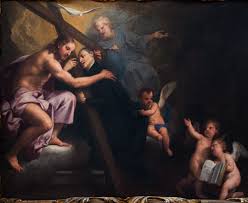Birth
Ignatius was born as Ignio (not Ignatius) in the Basque region of Northern Spain, was the youngest of thirteen children. and his mother died when he was seven. He was raised by the wife of a blacksmith. Loyola is the name of the village (and castle) he was born into, hence Ignatius of Loyola.

First job
At the age of sixteen, Ignatius was sent to serve as a page to the treasurer of the kingdom of Castile. There, he acquired a taste for all that the kingdom provided, including women and gambling. He left this job around the age of 18 to become a soldier, a somewhat more promising road to fame and nobility.

Life as a soldier
After a stint as a soldier, Ignatius sought wider acclaim and was known as a dualist. There’s a legend that he may have beheaded someone during a game of fast swords. During this, he altered his name from Inigo to Ignatius (Ignazio).
In May of 1521, at the age of thirty, Ignatius found him self as an officer who was in charge of defending Pamplona against the French. Outnumbered, his commander wanted to surrender, but Ignatius convinced him to “fight on for the honor of Spain, if not for victory.” During this battle, a cannon ball struck Ignatius, wounding one leg and severely mutilating the other. The French soldiers, admiring Ignatius’s great courage, carried him to his home in Loyola to recuperate, rather than to prison.

Conversion
During this time of healing, Ignatius asked for romance novels to pass the time, but since none could be found, he was given a copy of the Life of Christ and a book on the saints. Desperate, Ignatius read them and decided that the lives of the saints were far more fascinating than any romance novel. Ignatius began to notice that after reading about the lives of the saints and Christ, he was at peace and felt satisfied, whereas, after his long daydreams of fame, fortune, and romance, he would feel restless and unsatisfied. The beginning of his conversion also laid the ground work for his most well known work, his guide to spiritual discernment, also known as his Spiritual Exercises.

A hermit
Once he was well enough to get out of bed, Ignatius proceeded straight to the Benedictine shrine of Our Lady of Montserrat, made a general confession, and knelt all night in vigil before Our Lady’s altar. He left his sword and knife at the altar, went out, gave away all his fine clothes to a poor man, and dressed himself in rough clothes with sandals and a staff. He stayed in a cave outside of the town Manresa for ten months. His days were spent praying and working in hospice. It is said that here he had a vision of enlightenment which he regarded as the most significant moment in his life. Ignatius never revealed what took place or what was said in the vision, but this moment seemed to transform Ignatius and allowed him to see God’s creation with eyes of grace and mercy.

Priesthood
At thirty three, Ignatius was determined to become a priest, but he did not know Latin, so he had to go back to primary school to begin learning Latin grammar. From there, he moved to several different universities and got caught up with the Inquisition three separate times. His zeal for preaching was noticed by the local Inquisitors, and though they could not find any heresy in what he was preaching, being a lay preacher was suspicion enough—they wanted hi to continue but only after a proper education. After being jailed for forty two days, he was told to avoid teaching others until his education had been completed.
Eventually, he made his way to Paris to study Latin, literature, philosophy, and theology. There he met Francis Xavier. Upon graduation, Ignatius, Francis, and a few friends decided to take vows of chastity and poverty. They ended up in Rome, placing themselves at the disposal of the pope.

The Society of Jesus
Pope Paul III accepted Ignatius and his friends as an official religious order, the Society of Jesus, in 1540. After two deeply discerned, unanimous elections, and group insistence, Ignatius humbly accepted the honor of being the first leader, though he declined at first because he “had not lived a worthy life in his youth . . . and others were more experienced theologically.”
Ignatius imposed a strict rule on his order, which was expected to be a deterrent for new members, but the order grew rapidly.

Legacy
Before his death in 1556, Ignatius established 35 schools and the Society of Jesus had 1,000 members. He was beatified by Pope Paul V on July 27, 1609 and canonized on March 12, 1622. His feast day is July 31. He is the patron saint of the Society of Jesus, soldiers, educators, and education.

Comments